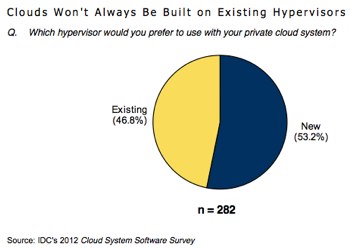IBM is not at all new to virtualization, but with its shift last month to an open source cloud architecture, the company has put a fresh effort into boosting market share for KVM, the open source Linux “Kernel-based Virtual Machine” for x86 servers.
In the past five months, IBM has opened the KVM Center of Excellence labs in Beijing and announced a second location in New York aimed at spurring enterprise adoption of KVM. IDC in February released the white paper “KVM: Open Virtualization Becomes Enterprise Grade,” co-sponsored by IBM and Red Hat. And in May IBM will lead a full day of sessions as part of the KVM End Users Technical Summit at the Linux Foundation’s Enterprise End User Summit in New York.
 “We want KVM to be a big enough presence in the market to keep prices low and affect the way other vendors do business,” said Mike Day, an IBM engineer focusing on virtualization and Linux. It doesn’t need to be a major player to help balance out the market, he added. Fifteen percent market share is their target.
“We want KVM to be a big enough presence in the market to keep prices low and affect the way other vendors do business,” said Mike Day, an IBM engineer focusing on virtualization and Linux. It doesn’t need to be a major player to help balance out the market, he added. Fifteen percent market share is their target.
Targeting High-Performance Workloads
Virtualization is strategic to all of IBM’s businesses, not the least of which is cloud computing. IBM uses Linux and KVM across most of its cloud products for both economic and performance reasons, Day said.
“With Linux and KVM, all the features we provide (in our hardware) are exploited,” Day said, “usually on the first day we ship the platform.”
Their KVM benchmarks push competitors Microsoft and VMware to more quickly develop the same capabilities, which allow their software to fully exploit IBM’s System X and Pure Systems platforms, Day said.
“If the virtualization layers don’t exploit the hardware then all of our hardware engineering is really wasted,” he said.
IBM also aims to push KVM into other workloads beyond the most common use for IBM customers, which is server consolidation. In particular, KVM holds an advantage for running high-performance workloads, such as trading applications, because of its direct access to low-latency improvements to the Linux kernel, Day said.
The VFIO user-space drivers, for example, have been a big help for boosting performance in virtualized workloads, he said. They make it easier to load drivers directly in a guest.

One of the biggest challenges to greater KVM adoption will be appealing to users with fewer in-house IT resources or less experience running Linux and KVM. The hypervisor needs better configuration defaults, Day said, not only for ease of setup and maintenance, but to avoid outages that make the news and give cloud services a bad name.
“When services go down it’s usually an operator error, “ Day said. “That means you need to make the interface foolproof and that’s really hard to do.”
IBM’s KVM User Council
IBM is the second largest contributor to KVM code behind Red Hat, with a team focused on scalability and performance issues. At the End User Summit in May, its KVM experts will lead panel discussions and presentations on KVM use cases and the technical roadmap for KVM.
The company will also form a KVM users council that will allow customers and vendors to exchange information about using KVM, as well as communicate directly with developers and distributors.
The Enterprise End User Summit will take place May 14-15 at the New York Stock Exchange in New York, NY. Request an invitation to attend.


